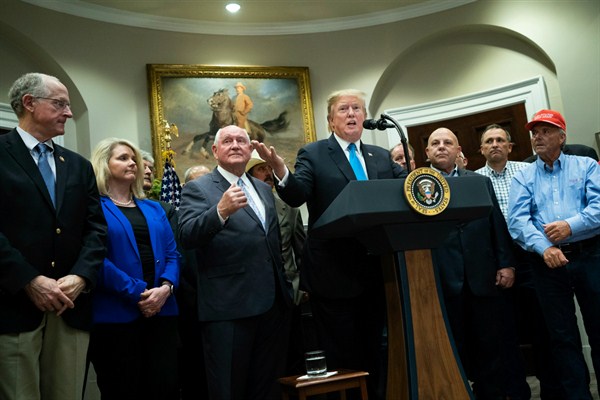Almost every week of late, it seems something new, startling and historically unusual is happening in U.S. trade policy. President Donald Trump’s actions are undermining the credibility of American negotiators, increasing uncertainty for traders and investors, domestic and foreign, and potentially threatening to throw the economy into recession. This is all happening in part because Trump refuses to acknowledge that Americans pay the tariffs he likes so much, and also because he still doesn’t understand how global supply chains work. With so many head-spinning developments this spring, it can help to step back and take stock of where things stand, how we got here—and just what the point of it all is.
One of Trump’s first actions after taking office in 2017 was to withdraw from the Trans-Pacific Partnership, or TPP—the major free trade deal with 11 other Pacific Rim countries that had been President Barack Obama’s signature piece of trade policy. Perhaps Trump thought the agreement would collapse without U.S. participation. If so, he miscalculated. With Japan leading the way, the other 10 countries moved forward to implement the agreement without the U.S., and it entered into force at the end of 2018. At that moment, the parties to the new deal began lowering their barriers to one another’s exports, putting U.S. exporters at a disadvantage, especially American farmers who rely heavily on the Japanese market. So far, the Trump administration has made little progress negotiating a separate bilateral trade deal with Japan.
At the beginning of 2018, the Trump administration went on the offensive, imposing tariffs on solar panel components and washing machines because those industries claimed they had been injured by imports, mainly from China and South Korea. These actions were taken under a safeguards mechanism that is seldom used in Washington because the tariffs apply to all imports in the affected sectors, and they can be relatively costly for consumers. In the case of washing machines, the safeguard action proved more costly than expected because manufacturers, taking advantage of the fact that consumers frequently buy washers and dryers together, raised the price of both items by more than 10 percent. Overall, analysts estimate that U.S. consumers paid $1.5 billion more for washers and dryers in 2018 as a result of the tariffs.

